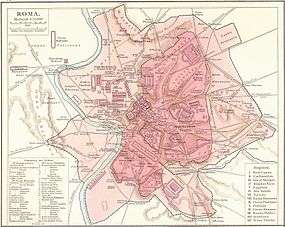Lacus Curtius
Coordinates: 41°53′31″N 12°29′12″E / 41.891967°N 12.486595°E
| Lacus Curtius | |
|---|---|
 The Lacus Curtius today | |
| Location | Regio VIII Forum Romanum |
| Built in | Archaic through Imperial periods |
| Built by/for | Unknown builder |
| Related | Roman Forum |
 Lacus Curtius | |
The Lacus Curtius was a mysterious pit in the ground in the Roman Forum, now small, more or less filled in and paved over with ancient stone, but once said to have been a widening chasm. Its nature and significance in Rome's early history is unknown, and this was already the case by the late Republican period. However the name of the place seems to be connected with the Curtia Gens, a very old Roman Family with Sabine origins.
It was, however, regarded with some veneration by the ancient Romans, and the story most often repeated is that told by Livy:[1] Rome was facing a peril which an oracle had stated would be overcome only when the City threw into the chasm what she held to be most dear. A young horseman named Marcus Curtius (a member of the Curtia Gens), saved the city: He understood that it was the life of a brave Roman youth that the Romans held most dear, and therefore plunged into it in full armour on his horse, whereupon the earth closed over him and Rome was saved.[2]
Alternatively, Titus Livius tells that the Lacus Curtius was named after Mettius Curtius, a Sabine horseman who rode into or fell into it while fighting against Romulus, during the war begun after the Rape of the Sabine Women.
Still another version, told by historian Marcus Terentius Varro had it that Gaius Curtius Philon, a consul of 445 BC, consecrated the site after a lightning strike opened it.[3]
Related links
External links
References
- ↑ Liv. vii.6
- ↑ Susanne William Rasmussen (2003). Public Portents in Republican Rome. L'ERMA di BRETSCHNEIDER. pp. 39–. ISBN 978-88-8265-240-1.
- ↑ Varro Ling. 5.150
| Wikimedia Commons has media related to Lacus Curtius (Rome). |